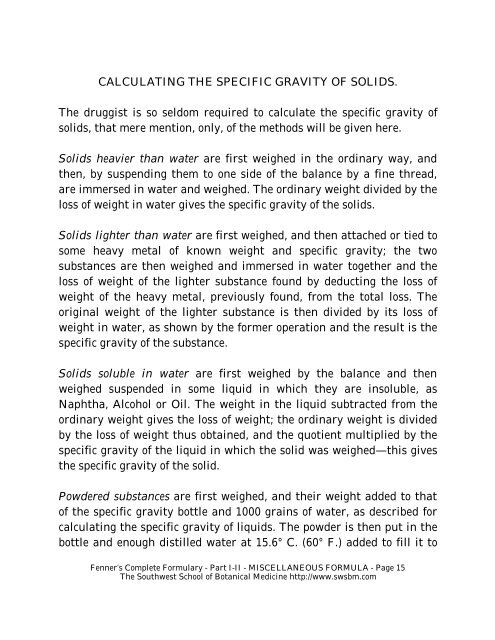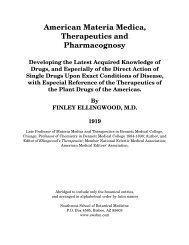Fenner's Complete Formulary - Southwest School of Botanical ...
Fenner's Complete Formulary - Southwest School of Botanical ...
Fenner's Complete Formulary - Southwest School of Botanical ...
You also want an ePaper? Increase the reach of your titles
YUMPU automatically turns print PDFs into web optimized ePapers that Google loves.
CALCULATING THE SPECIFIC GRAVITY OF SOLIDS.<br />
The druggist is so seldom required to calculate the specific gravity <strong>of</strong><br />
solids, that mere mention, only, <strong>of</strong> the methods will be given here.<br />
Solids heavier than water are first weighed in the ordinary way, and<br />
then, by suspending them to one side <strong>of</strong> the balance by a fine thread,<br />
are immersed in water and weighed. The ordinary weight divided by the<br />
loss <strong>of</strong> weight in water gives the specific gravity <strong>of</strong> the solids.<br />
Solids lighter than water are first weighed, and then attached or tied to<br />
some heavy metal <strong>of</strong> known weight and specific gravity; the two<br />
substances are then weighed and immersed in water together and the<br />
loss <strong>of</strong> weight <strong>of</strong> the lighter substance found by deducting the loss <strong>of</strong><br />
weight <strong>of</strong> the heavy metal, previously found, from the total loss. The<br />
original weight <strong>of</strong> the lighter substance is then divided by its loss <strong>of</strong><br />
weight in water, as shown by the former operation and the result is the<br />
specific gravity <strong>of</strong> the substance.<br />
Solids soluble in water are first weighed by the balance and then<br />
weighed suspended in some liquid in which they are insoluble, as<br />
Naphtha, Alcohol or Oil. The weight in the liquid subtracted from the<br />
ordinary weight gives the loss <strong>of</strong> weight; the ordinary weight is divided<br />
by the loss <strong>of</strong> weight thus obtained, and the quotient multiplied by the<br />
specific gravity <strong>of</strong> the liquid in which the solid was weighed—this gives<br />
the specific gravity <strong>of</strong> the solid.<br />
Powdered substances are first weighed, and their weight added to that<br />
<strong>of</strong> the specific gravity bottle and 1000 grains <strong>of</strong> water, as described for<br />
calculating the specific gravity <strong>of</strong> liquids. The powder is then put in the<br />
bottle and enough distilled water at 15.6° C. (60° F.) added to fill it to<br />
Fenner’s <strong>Complete</strong> <strong>Formulary</strong> - Part I-II - MISCELLANEOUS FORMULA - Page 15<br />
The <strong>Southwest</strong> <strong>School</strong> <strong>of</strong> <strong>Botanical</strong> Medicine http://www.swsbm.com
















